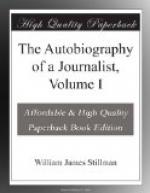He seemed to me a shallow philosopher, but I must confess that my treatment of him did not become a man so much younger than he. I felt, however, a certain amount of honest indignation at what seemed to me his charlatanic manner of putting off on people his random and improvised suggestions regarding questions which seemed to me then of vital importance to society. It is easy now to see that I was in the stage of mental evolution at which detail is of supreme importance because large views of life and philosophy have not yet come above the horizon. Alcott was a drawing-room philosopher, the justice of whose lucubrations had no importance whatever, while his manner and his individuality gave to wiser people than I the pleasure which belongs to the study of such a specimen of human nature. He amused and superficially interested, and he no doubt enjoyed his distorted reflections of the wisdom of wiser men as much as if he had been an original seeker. I did not then understand that all knowledge is relative, and that, au fond, his offense was the same as mine, that of thinking he had arrived at finality in the discovery of truth.
It was, perhaps, a natural consequence of all this talking and writing about art that, in the absence of a periodical devoted to it, my friends came to the conclusion that it would be a good and useful thing that I should start an art journal. I had read with enthusiasm “Modern Painters,” and absorbed the views of Ruskin in large draughts, and enjoyed large intercourse with European masters, and with Americans like William Page, H.K. Brown, S.W. Rowse, and H.P. Gray, all thinkers and artists of distinct eminence. In this school I had acquired certain views of the nature of art which I burned to disseminate. They were crude rather than incorrect, but they were largely responded to by our public; they were destructive of the old rather than informing of the new, and leaned on nature rather than art. The art-loving public was full of Ruskinian enthusiasm, and what strength I had shown was in that vein. The overweening self-confidence that always carried me into dangers and difficulties which a little wisdom would have taught me to avoid, made me too ready to enter into a scheme which required far more ability and knowledge of business than I possessed. All my artist friends promised me their assistance, and I found in John Durand, the son of the president of the National Academy of Design, a partner with a seconding enthusiasm and the necessary assistance in raising the capital. This amounted to $5000, for the half of which my brother Thomas became security. We doubted not that the undertaking would be a lucrative one, and one of the principal motives which was urged on me by my artistic friends and promising supporters was that it would furnish me with a sufficient income to enable me to follow my painting without any anxiety as to my means of living. We started a weekly called “The Crayon,” and at the outset I was able to promise the assistance of most of our best writers residing in New York.




